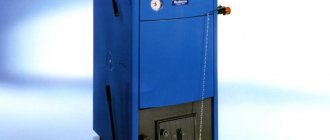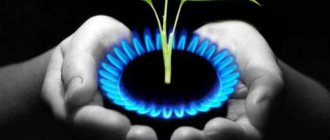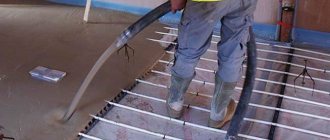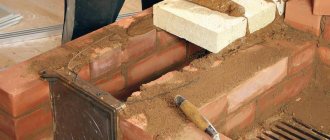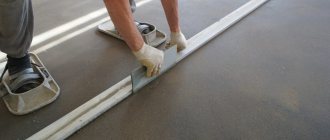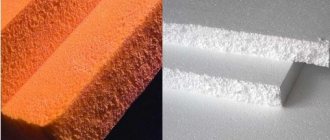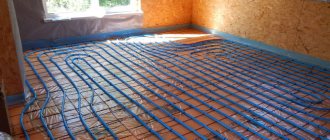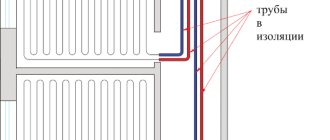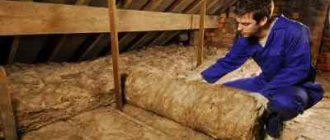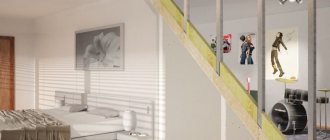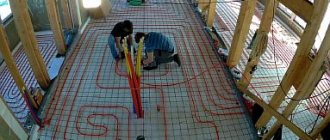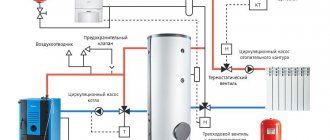The high-pressure unit pumps out components from 200 liter drums using barrel pumps, which are lowered and fixed to the neck of each barrel. Then the components enter the main pump of the installation, having previously passed through the heating unit. Then the main drive of the installation supplies the heated components under high pressure into the working hose (sleeve), which also has its own heating system. A spray gun is mounted at the end of the working hose. For the convenience of the operator, the thermal casing does not reach 3 meters to the gun itself. This allows the operator to move his hand more freely. The system for supplying components to the spray gun is designed differently by all manufacturers. But in any case, this method of spraying components is airless . This means that the components come out of the gun as a torch with no air in it. In high pressure installations, air is supplied to the gun only to clean the nozzle.
Application of polyurethane foam
Polyurethane foam is very popular. It is actively used both at the initial stage of construction and as an additional thermal insulation material:
- During the construction of warm hangars. Polyurethane foam is applied directly to the metal base of the room. Due to its excellent adhesive properties, the material adheres to the walls of the hangar without the construction of additional supporting structures.
- Insulation of residential and non-residential buildings. Polyurethane foam is used in private construction and in the construction of non-residential buildings. The material is used in the construction of frame houses. It is applied as an outer layer of insulation under a ventilated facade.
- Insulation of attics and roofs. The roof is one of the most common objects where polyurethane foam is used. The material is applied between the joists and is used to replace old insulation. The polyurethane foam layer can become an additional barrier to moisture.
- When installing a large number of doors or windows. For example, during the construction of an apartment building. In this case, polyurethane foam will cost less than conventional polyurethane foam.
- When insulating floors and walls. In any type of premises where you need to make thermal insulation between rooms or floors.
- For insulating surfaces of complex shapes. Very often, PPU is recommended by architects when designing a building with complex elements: columns, bay windows, ledges, arches.
- During the installation of refrigeration shops and freezers. The material helps maintain the desired temperature indoors. It plays the role of a heat insulator.
- For insulation of water supply and sewerage pipes. An excellent solution in the country or on your own plot. Polyurethane foam will retain heat in the pipe. It won't be torn apart in the cold.
Often, working with polyurethane foam is cheaper than using other types of insulation. But the advantages of the finishing material do not end at this point.
Areas of application of polyurethane foam filling technology
Installations for pouring polyurethane foam are effective means of combating corrosion. Surfaces containing a layer of polyurethane foam have a high degree of resistance to wear. Similar technologies are used in all production areas:
- mechanical engineering;
- mining industry - conveyors, rollers, rubbing units;
- rubber industry;
- chemical, instrument-making, housing and communal services.
Using a layer of polyurethane foam can significantly reduce the cost of metal components and parts, bringing enormous savings.
Advantages of PPU
The material is valued for a number of qualities:
- High adhesive properties. It is used to insulate various surfaces: concrete, wood, metal, stone, HDPE, PVC, brick. The material does not fall off or break under its own weight. It can be sprayed onto the ceiling or other sloped surfaces.
- Low thermal conductivity. The material has a thermal conductivity coefficient of 0.018 W/m °C. This is almost three times lower than that of a mineral wool slab (0.045 W/m °C). PPU is valued as a reliable and, most importantly, durable thermal insulation material. The average service life of finished insulation is about 30 years. It is used in the insulation of private buildings and industrial buildings, workshops, factories and hangars. The polyurethane foam is applied in an even layer. There are no cold bridges in it, as happens with mat-shaped insulation.
- Excellent soundproofing qualities. Polyurethane foam is a foamed substance. Due to this consistency, it dampens most vibrations that fall on its surface. The material is perfect for private homes where you need to create a sound partition between two rooms.
- Resistant to temperature changes and fire. Operating temperatures of polyurethane foam: from - 90 to + 130°C. It is used as a heat shield when arranging freezing shops, to cover hot pipes. Temperature changes do not in any way affect the basic properties of the material. It does not deteriorate and does not change shape. Some manufacturers produce fire-resistant polyurethane foam with flammability classes: from G1 (low-flammability) to G3 (self-extinguishing).
- Lightness and strength. The material is applied in a continuous layer. It forms a single monolithic crust. This adds strength to the structure. PPU weighs practically nothing. Hugo specific gravity ranges from 3 to 20 kg/m3. Such properties make polyurethane foam an almost indispensable assistant for insulating light roofs and attics.
- Easy installation and post-processing. The foam is easily applied to any surface. It easily fills all the voids, seams, joints, cracks. After drying, excess material can be easily removed with a simple stationery knife. Foam does not produce harmful dust and crumbs, as happens, for example, with mineral wool.
The material goes well with other types of finishes. It is quite environmentally friendly and does not harm human health.
Types of filling polyurethane foam
The polyurethane foam filling installation is a mechanized complex, inside which two liquid components are mixed qualitatively. It is a polyol and isocyanate. According to the documentation adopted in the Russian Federation, polyol is labeled as component A, isocyanate as component B. A dosed volume of these liquids is supplied to the mixing chamber.
IMPORTANT! The components are thoroughly mixed in the chamber. This function is performed by a dynamic mixer without the use of compressed air. The composition obtained as a result of mixing is fed into a form prepared specifically for this operation. A similar process is called polyurethane foam filling.
There are a number of excellent domestic manufacturers of installations for filling. The most popular products on the Russian polyurethane foam market are aggregates, Moscow. The company is an industry leader and offers its partners various types of machines for pouring polyurethane foam:
PK-60 – 60 liters per minute;
PK-90 – 90 liters per minute;
PK-200 – 200 liters per minute.
Each unit differs slightly from the others in its design, mainly in performance. The basis of all complexes:
- filling unit;
- hydropneumatic capacity;
- pump dosing device.
The remaining components and mechanisms are additional options used to automate, simplify, and control the quality of the pouring process. Depending on the type of foam used and performance, each filling foam is equipped with them. You can buy such equipment on the Internet portal and through the sales department of the enterprise.
Differences in machine performance
Each filling machine has its own production volumes and individual power characteristics. It is not difficult to buy equipment for pouring polyurethane foam, however, before purchasing it is necessary to clearly analyze your own needs for this equipment. The unified classification of polyurethane foam filling equipment provides for the production of two groups of machines:
- Small, with a filling capacity of up to 12 liters per minute.
- Large, with a filling capacity of up to 48 liters per minute.
NOTE!
Small units are equipped with 3G electric motors with a power of 0.75 kW and a voltage of 220 V. The rotor rotates under load inside the mixing chamber with a frequency of 3000 - 4200 rpm. The volume of the mixing chamber is 200 cm³. Manufacturer's warranty: one year from the date of commissioning into permanent operating mode, but no later than 90 days from the date of sale.
Large units are equipped with 3G electric motors with a power of 0.75 kW and 1.1 kW, a voltage of 380 V. The rotor rotates under load inside the mixing chamber with a frequency of 3900 - 4500 rpm. The volume of the mixing chamber is 280 and 340 cm³. Manufacturer's warranty: one year from the date of commissioning into permanent operating mode, but no later than 90 days from the date of sale.
Difference in linear and autonomous operation
When operating low-pressure units, the components are mixed in a mixing chamber with a working pressure of 6-10 atm. When pouring, the entire mass is mixed with a mixer. The latest models produced by Polymer-Complex PC are equipped with polyol and isocyanate heating units.
The high-pressure polyurethane foam system mixes components in a mixing chamber at an operating pressure of 140 atm. With this technology, the components are mixed, penetrating each other. The price for a high-pressure installation on the polyurethane foam market reaches 300,000 rubles. The polyurethane foam filling system in Moscow involves the parallel operation of both low and high pressure units.
ADDITIONAL INFORMATION
Autonomous operation of the PU foam filling machine consists in the complete independent functionality of the unit. Mixing of liquid substances is carried out in a closed chamber. Next, the mixture flows through a rod with slot-shaped nozzles into the poured mold. Polymerization of the resulting emulsion is achieved instantly through a spray torch on the surface of the base.
The installation is equipped with special guns to accurately hit the foam jet into the mold. The productivity is 6-20 liters per minute. This is how an autonomous pouring machine works. The installation price is 50-100 thousand rubles. Linear pouring machines are not much different from their stand-alone counterparts. They successfully work on main pipeline routes and bridge construction.
Their filling molds are much larger. Linear units have a capacity from 10 to 500 liters per minute. The cost of such units is 300,000 - 500,000 rubles or more.
Spray equipment
Devices for spraying polyurethane foam can be called full-fledged installations. Most often these are semi-stationary (portable) or mobile (on wheels) stations. The operating principle of such devices is identical for different models. All installations are devices for supplying basic components under low or high pressure. There are two types of devices:
- for spraying;
- for filling.
We are interested in units of the first type. Let's look at the main components of such an installation:
- compressor for air supply;
- containers for components;
- compressed air hoses;
- component supply hoses (ISO/POL);
- PPU supply hose section;
- compressed air supply to the installation;
- control unit - installation;
- recirculation hose;
- temperature sensor (TCS);
- spray gun.
Installation connection diagram:
- Hoses for supplying compressed air from the compressor are supplied to two containers (ISO/POL).
- Another hose from the compressor is led directly to the control unit (installation).
- The installation comes with hoses from containers. Compressed air is also supplied here. The latter pushes the mixed mixture through the main hose section into the spray gun.
- The central unit of the installation monitors the pressure in the tanks, supplies power to the compressor, mixes and heats the two components.
- The temperature sensor shows the state of the mixture and its viscosity.
It is important to consider the temperature of the finished mixture. So, a PU mixture is suitable for winter within the range: from + 30 to + 40°C. In other seasons, the permissible temperature range is from + 60 to + 80°C.
Correct operation
Let's consider the basic rules for operating PPU installations:
- Break in work for 1-2 hours, change components. What you need to do is: turn off the installation, turn off the heating of the components, relieve pressure in the system. Switching on is in reverse order.
- Shut down, turn off the installation for the night. You need to do: turn off the installation, heating; Relieve pressure in hoses. Then you need to shut off the supply of components so that there is no air pressure inside the hoses. Turn off the taps at the inlet where the components are taken in and disconnect the supply hoses. Close the taps on the gun, disconnect the mechanism connecting the spray nozzle to the main hose. Remove the gun.
- To start the installation after being idle for 1-2 days. Connect the hoses to the inlet, connect the gun. Turn on the taps. Start the installation. Remove any remaining air from the system. After this you can start working.
- For long-term preservation more than 1 week. Repeat the same steps to complete the job. It is important to install “dry” so that any remaining components leave the system. Disconnect the outlet hoses and remove the gun. Place the device under an awning or in a dry room.
- Flushing the circuit with isocyanate. Be sure to flush the hose and system with a special fluid. Substitute a special solvent instead of isocyanate. Flush the system one circuit at a time, then run regular machine oil through it. This method allows you to preserve the installation for up to 6 months.
The gun is also disassembled and cleaned with a special liquid.
Equipment advantages
- Many years of experience and professionalism of the company’s specialists. Work in Russian and foreign markets since 1989.
- Flexible pricing policy and discount system.
- Short delivery and setup times for equipment.
- Numerous diplomas and certification of all products.
- The company is a leader in the Russian market and a supplier to numerous foreign partners.
Conclusion
When purchasing equipment for pouring polyurethane foam, each owner of his own production must calculate its capacity and the need for the purchase of such equipment. You should also know exactly the volume of expected work on pouring polyurethane foam.
Particularly careful calculations must be made when selling products filled with polyurethane foam, the presence of interested buyers, market needs, and transportation and procurement costs. Then all costs will quickly pay off and bring a decent profit to the owner of the enterprise.
Examples from the catalog
Let's look at two PPU installations that are worth paying attention to:
- "ARC RP1". Supplied with sprayer. Overall dimensions: 420x350x290 mm (not mobile installation); weight without hoses – 15 kg; productivity l/min – up to 2; performance adjustment is electronic, the POL/ISO component ratio is 1:1 basic (from 1:1 to 1:1.7 in increments of 0.1 - when purchasing additional gears). Price: RUB 66,930.
- "ARC P2". Supplied complete with RP1 sprayer. Overall dimensions: 570x630x540 mm (mobile installation); weight without/with heaters - 53/70 kg; productivity l/min – 1.6. The installation can be equipped with volumetric flow-through component heaters with a separate control panel (optional). Reliable industrial asynchronous electric motor with coaxial gear motor. The POL/ISO component ratio is 1:1 basic (from 1:1 to 1:1.7 in increments of 0.1 - when purchasing additional gears). Price on request.
Each installation is supplied with a passport with instructions, pressure hoses, and a spare parts kit. Both units operate on power supply: V 220±5%.
HIGH PRESSURE UNIT MANUFACTURERS
The equipment overview provides a brief description of the key parameters and main characteristics. A review of high-pressure installations for spraying polyurea and polyurethane foam is not a recommendation from one manufacturer or another. You must decide for yourself which type of machine will be more convenient for you to work with in the future.
To save your time, we recommend that you write a request to our e-mail and we will send it to specialists from equipment manufacturing companies. In the letter, indicate your full contacts and detailed terms of reference (what you plan to do).
Graco (USA) – REACTOR
High pressure units with electric drive of the dosing unit. The most common installations among PPU contractors. They are successfully promoted through a wide dealer network.
Garraf Maquinaria, SA (Spain) – GAMA EVOLUTION
The second most popular equipment for working with polymer protective coatings. The range of machines includes units with hydraulic and pneumatic drive. Also, some professional devices can operate from a 220V network.
TEC MAC (Italy) – ISOLTEC
Pneumatic and hydraulic high-pressure installations for spraying polyurethane foam and polyurea. One of the simplest and most reliable installations. They have been introduced to the Russian market relatively recently, but are confidently gaining the trust of contractors.
Wilhelm Wagner GmbH & Co. KG WIWA (Germany) – DUOMIX
Pneumatic and hydraulic high-pressure installations for spraying polyurethane foam and polyurea. European quality for reasonable money.
NINGBO DINO-POWER MASHINERY Co (China) – DINO-POWER
One of the rarest installations on the Russian market of spraying equipment. About 5 years on the Russian equipment market.
PMC Global Inc (USA) – HP SERIES
Classic American high-pressure installations for spraying multicomponent polymer coatings. The most common cars in the United States of America. They are imported to Russia only by special order.
Energy (Russia) – PROTON EVOLUTION
Little-known equipment from a Russian manufacturer. Practically not found among PPU contractors. Sold only through the manufacturer.
INTERSKOL (Russia) – N; E; R;
At the beginning of 2016, the Russian manufacturer of electrical equipment released four lines of installations for spraying polyurethane foam and polyurea, as well as its hybrids.
JINAN SAIJUN TECHNOLOGY (China) – FD
Chinese manufacturer of professional equipment for processing polyurethane foam components. The line of installations includes only machines for spraying and pouring polyurethane foam. However, a professional gun with an internal mixing chamber is used.
